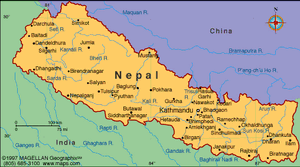Muktinath
| Author:Laxman Burdak, IFS (R) |

Muktinath (मुक्तिनाथ) is a Vishnu temple, sacred to both Hindus and Buddhists in Mustang, Nepal.
Variants
- Muktinatha मुक्तिनाथ, नेपाल, (p.749)
Location
Muktinatha is about 225 km from Kathmandu. It is located in Muktinath Valley at the foot of the Thorong La mountain pass in Mustang, Nepal. It is one of the world's highest temples (altitude 3,800 m). The site is close to the village of Ranipauwa, which is sometimes mistakenly called Muktinath.
History
This temple is considered to be 106th among the available 108 Divya Desam (premium temples) considered sacred by the Sri Vaishnava sect. Its ancient name in Sri Vaishnava literature was in 10 th CE (means after 0 year ) while Buddhism was in 568 BCE (Before Christ emerged - Before 0 year ), origin, is Thiru Saligramam. This houses the Saligram shila, considered to be the naturally available form of Sriman .
Buddhists call it Chumig Gyatsa, which in Tibetan means "Hundred Waters". For Tibetan Buddhists, Muktinath is an important place of dakinis, goddesses known as Sky Dancers, and one of the 24 Tantric places. They understand the murti to be a manifestation of Avalokiteśvara, who embodies the compassion of all Buddhas.[1]
Shakti Peetha
The Muktinath Temple is considered to be a Shakti Peetha for a yatra. It is one of the 108 Siddhpeeth and is named Mahadevi [Devibhagwat 7.14]. Shakti Peethas are sacred abodes of Shakti (primordial cosmic energy), formed by the falling body parts of the corpse of Sati Devi, when Lord Shiva carried it as he wandered. 51 Shakti Peethas are revered by Shaktism, connecting them to the 51 alphabets in Sanskrit. Each Shakti Peetha has a Shakti shrine and a Bhairav shrine in its temple. The Shakti of Muktinath is addressed as "Gandaki Chandi", and the Bhairava as "Chakrapani". Sati Devi's temple on the forehead is believed to have fallen there.[2]
मुक्तिनाथ, नेपाल
मुक्तिनाथ (AS, p.749): नेपाल में समुद्रतट से 12000 फुट की ऊंचाई पर स्थित प्राचीन हिंदू तीर्थ है जिसका महत्व पशुपतिनाथ के समान ही समझा जाता है. तिब्बत के बौद्ध भी इस [p.750] स्थान को पवित्र मानते हैं और इसे छुमिकग्यासा कहते हैं. कृष्ण-गंडकी नदी मुक्तिनाथ की हिमाच्छादित पर्वत माला से निकलती है और मुक्तिनाथ के पास देविका तथा चक्रा नामक नदियों से मिल जाती है. मुक्तिनाथ काठमांडू से प्राय: 140 मील दूर है. भारत से यहां पहुंचने के लिए नौतनव या बुटवल होकर मार्ग जाता है. [3]
मुक्तिनाथ परिचय
मुक्तिनाथ नेपाल की राजधानी काठमांडू से 140 मील की दूरी पर स्थित प्रसिद्ध तीर्थस्थान है। यह शालग्राम क्षेत्र है। दान भंसार से ही गंडकी के तट पर तथा पर्वत पर शालग्राम शिला मिलने लगती हैं। मुक्तिनाथ हिमप्रदेशीय यात्रा है। अतः मई से सितंबर तक इस यात्रा का अनुकूल समय है। दामोदर कुंड की यात्रा अगस्त-सितंबर में करना उचित है।
यात्रा का मार्ग काफ़ी कठिन है। इसलिए यात्रा में आवश्यक सामान साथ ले जाना उचित है। जैसे- कम्बल, टार्च, गरम कपड़े, घड़ी, बरसाती, धूप का चश्मा, वेसलीन, खटाई, दस्ता ने आवश्यक हैं।
काठमांडू से मुक्तिनाथ 140 मील दूर है। काठमांडू या गोरखपुर से पोखरा तक हवाई जहाज या मोटर बस से जाना चाहिए। पैदल मार्ग पोखरा से इस प्रकार है- नागडांडा – 7 मील, घोरे पानी – 9 मील, दानभंसार – 9 मील, टुकचे बाज़ार – 11 मील, मुक्तिनाथ – 12 मील
मुक्तिनाथ में नारायणी नदी में सात झरने गरम पानी के हैं। नदी के उद्गम के समीप अग्नि ज्वाला दिखती है। यहाँ कई मंदिर तथा धर्मशालायें हैं। मुक्तिनाथ 51 शक्तिपीठों में से एक है। यहाँ सती का दाहिना गण्डस्थल गिरा था। यहाँ मार्ग में ठहरने के स्थान तथा ग्राम बाज़ार मिलते हैं।
संदर्भ: भारतकोश-मुक्तिनाथ
External links
References
- ↑ Zurick, David (2006). Illustrated Atlas of the Himalayas. Lexington: University Press of Kentucky. p. 153.
- ↑ (Translator), F. Max Muller (June 1, 2004). The Upanishads, Vol I. Kessinger Publishing, LLC. ISBN 1419186418; (Translator), F. Max Muller (July 26, 2004). The Upanishads Part II: The Sacred Books of the East Part Fifteen. Kessinger Publishing, LLC. ISBN 1417930160.
- ↑ Aitihasik Sthanavali by Vijayendra Kumar Mathur, p.749-750

